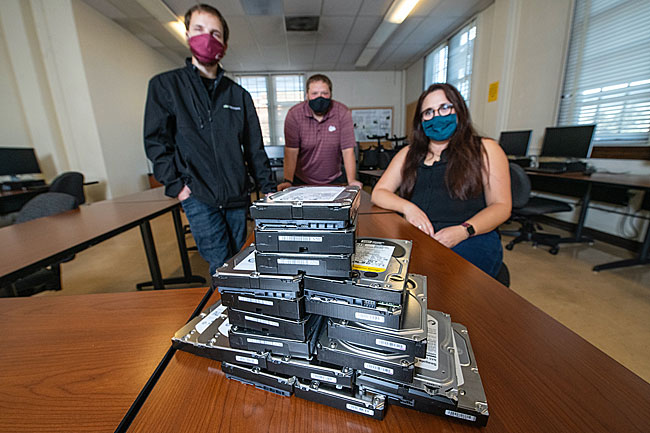UM Earns Grant to Boost Research Network Infrastructure

MISSOULA – The University of Montana recently was awarded $310,000 from the National Science Foundation to build a secure high-speed network dedicated to scientific data transfers. The grant was earned by acting Chief Information Officer Zach Rossmiller and a diverse team of UM researchers and IT professionals.
This specialized network architecture often is referred to as a Science DMZ. Its main purpose is to provide researchers with the ability to quickly send and receive large amounts of data over the internet.
Rossmiller will serve as the principal investigator for the two-year grant.
“The Science DMZ was the next step in UM’s research infrastructure plan and follows the successful launch of UM’s first shared compute cluster,” he said. “While all of the money from this award will be used to cover the cost of the network hardware, it’s the specific needs of some of UM’s brightest researchers that drove our efforts to improve the infrastructure.”
He attributes recent UM success in boosting its research infrastructure to his collaboration with Chuck Harris, director of the Social Science Research Laboratory, and close work with UM’s research community.
The co-principal investigators on this project are Erin Landguth, an associate professor in the School of Public and Community Health Sciences and director of the Computational Ecology Lab; Jeffrey Good, an associate professor in the Division of Biological Sciences; and Tung-Chung Mou, an assistant research professor and core facility manager in the Center for Biomolecular Structure and Dynamics.
Research needs, along with documented limitations from additional projects, helped make the case for a Science DMZ. One of the projects used to demonstrate need came from Tre Blohm, an anthropology doctoral student researching operations for pathogenic screening of ancient DNA.
Due to limited transfer speeds and the large amount of data exchanged with collaborators at Harvard University and the National Center for Biotechnology Information laboratories, Blohm found that storing data files on hard disks and sending them by mail was the only workable solution. This created extra work and caused delays in the research. Upon completion, UM’s Science DMZ will provide a much better solution for Blohm and others in big-data and data-intensive science fields.
Although this project was driven by researcher needs, it also provides academic possibilities.
“The Science DMZ project was designed to provide experiential learning opportunities for UM students,” Rossmiller said. “Letters submitted with the proposal indicate that several programs are interested in offering student internships to support the project.”
Dr. Sara Rinfret, director of UM’s Master of Public Administration program, wrote in a letter of support: “(The Science DMZ) will provide our students with an opportunity to assist central IT network professionals in the development and drafting of the security and use policies.”
Rossmiller knows this support is critical.
“A successful Science DMZ must have strong network security policies,” he said. “The M.P.A. student involvement is extremely important. Deploying enterprise-level technology, like a Science DMZ, requires special knowledge and skills that are sometimes best learned through experience.”
Dr. Thomas Gallagher, dean of Missoula College, recognized the educational potential of this project from the start.
“This is a great experience for our students,” Gallagher said. “We focus to provide our students the opportunity to receive on-the-job training while they get their degree. Their ability to participate on a project like this will be invaluable for them.”
Gallagher plans to provide IT student internships to help deploy and maintain the new UM Science DMZ.
Rossmiller said he strives to include researchers, educators and students as collaborators on IT projects.
“When I’m able to establish a project where researchers benefit, faculty are involved and excited to participate, and students are learning and gaining experience, I count that as a win,” he said. “These kinds of wins, along with an improved research infrastructure, will help UM attract quality students, educators and researchers who expect access to high-performance computing and high-speed end-to-end data transfers to conduct their work.”
###
Contact: Zach Rossmiller, acting chief information officer and UM executive director of cyberinfrastructure, 406-243-6556, zachary.rossmiller@umontana.edu.